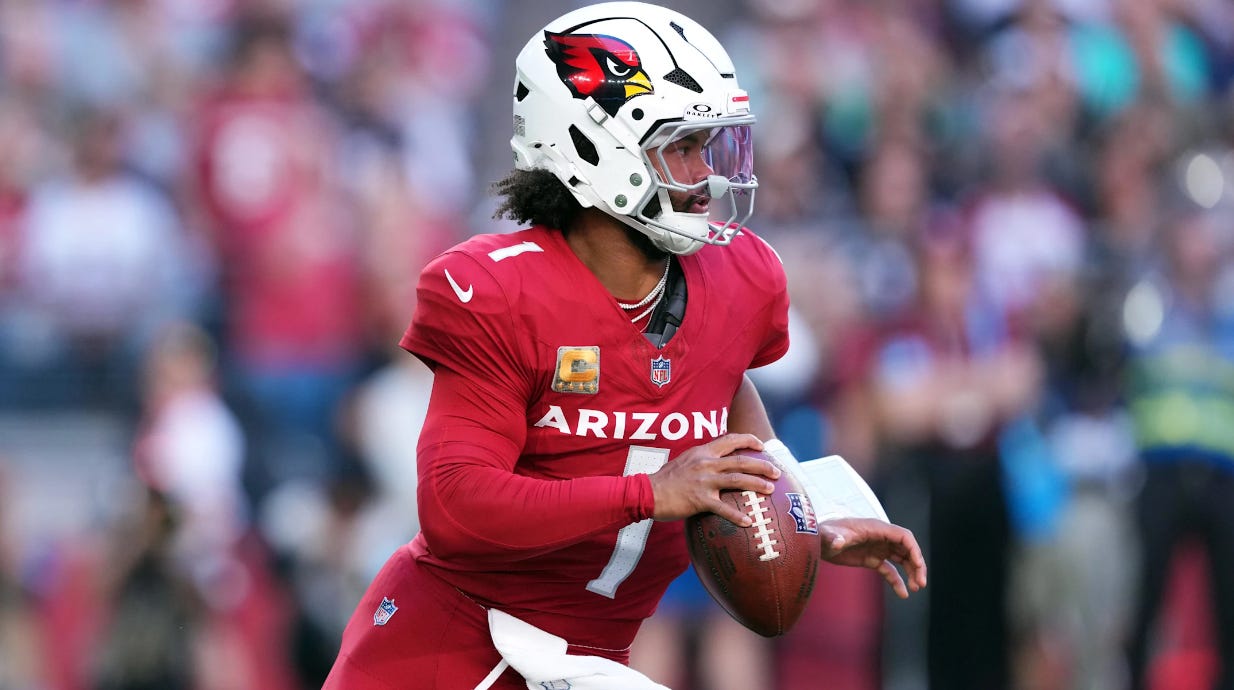Week 11 Bayesian Quarterback Rankings
Kyler Murray jumps into the top-12, and Bryce Young is no longer at the bottom
The big, fundamental change to the rankings this season is the integration of Adjusted Quarterback Efficiency (AQE) numbers. This produces rankings that align more closely to what the typical football observer or data-based analysts would assign based on a combination of observation and statistics.
For the Week 1 projection, I weaved the AQE figures for 2023 and 2022 into the mix. In Week 2, I discovered the addition of prior years’ charting from FTNData, enabling us to go back to 2019 and calculate AQE. Because we’re shifting the historical data for several years in the new projections, the projection movement from Week 1 wouldn’t be primarily based on last week’s quarterback performances, but mostly on revisions to 2019-2021 efficiencies.
You can find all the previous weekly editions of the Bayesian Quarterback Rankings here, and the backlog for Adjusted Quarterback Efficiency is here.
COMPARING GRADES AND EFFICIENCY
PFF grades aren’t part of the analysis, but I find it helpful to make not of how they align with EPA per play, as many contextual elements of quarterback play (drops, interception-worthy throws, easier throws that become big gains, etc) are part of the grading methodology, but aren’t accounted for in EPA. At the same time, I think EPA does a vastly superior job of weighing what is and isn’t important in points-based results.
The plot below is a bit different than previous iterations of this post, substituting AQE for unadjusted EPA per play, and you might notice that the data has less dispersion (i.e. something like a higher r²) than using straight EPA. Even so, AQE doesn’t perfectly align with PFF grading, and you can decide which measure is more representative of fundamental quarterback play. (hint: it’s AQE!)
Lamar Jackson is better than even money to win MVP with around half the season remaining, and that sentiment aligns with PFF grading and AQE. Jayden Daniels was always going to be more likely to regress as a rookie without the same track record of strong performance. Kyler Murray also leaped Daniels in AQE, but remains materially lower in grading. Joe Burrow gets more love from grading that AQE, and my intuition agrees with AQE that he’s more like the fifth best quarterback this year than second.
NFC North quarterbacks Jordan Love and Sam Darnold have the biggest gap between their AQEs and what you’d expect based on their PFF grades. Because of his prior poor performance, the Bayesian model isn’t buying Darnold as an above average quarterback yet, but it’s very high on Love.
PROJECTED ADJUSTED EFFICIENCY
These results are the ranking for the go-forward projections of adjusted quarterback efficiency starting this week. I also included the AQE rankings for each quarterback over the last five seasons (minimum 250 dropbacks) so you can see the evidence going into the projections. All of these ranks are now based on AQB, including the 2024 numbers.
Older data is decayed over time, so the 2023 and 2024 AQE data matters more than those from pre-2020. That said, older data can’t be fully discounted, or else you miss bounce-back performers of great quarterbacks returning to form, like Aaron Rodgers in 2020 and 2021.
“Percentile” is the mean (“best guess”) projection as a percentile of historical franchise quarterback results (min 2K career dropbacks).
Keep reading with a 7-day free trial
Subscribe to Unexpected Points to keep reading this post and get 7 days of free access to the full post archives.






